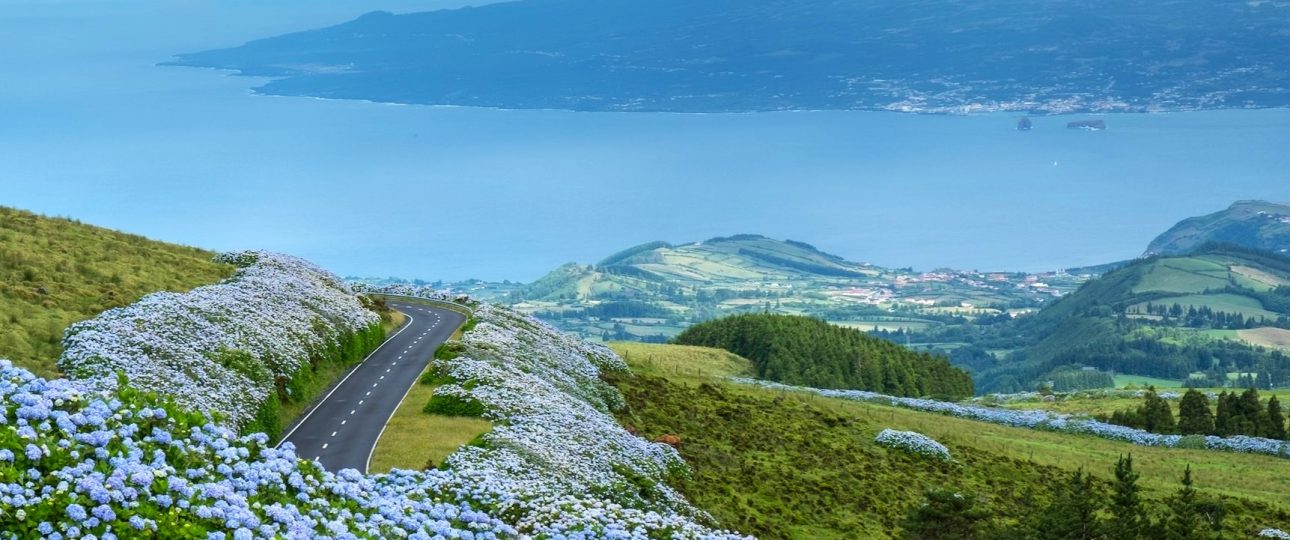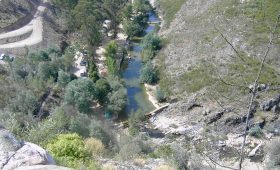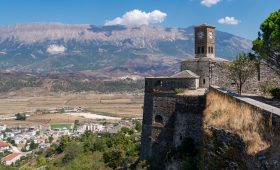Faial Island: A Jewel of the Azores
Faial Island is part of the central group of the Azores archipelago, known as the “triangle islands,” which also includes São Jorge and the nearby Pico Island, separated by the Faial Channel, a narrow sea passage approximately 8 km wide. With an area of about 172 km2, Faial stretches 21 km in length and up to 14 km in width. Discovered in 1427 and settled in 1432 by Flemish colonists, the island was named for the abundant “faias” (beech trees) found there. However, it is the vast expanses of blue hydrangeas that truly define its landscape, earning it the nickname “the Blue Island.”
By the 17th century, Faial had become a bustling commercial hub due to its strategic location as a port of call between Europe and the Americas. More recently, it has served as a vital communication link between continents and is now a key destination for international yachting.
The island’s highest point is Cabeço Gordo, located centrally, reaching an altitude of 1,043 meters. On clear days, this natural viewpoint offers breathtaking vistas of the triangle islands and even the distant Graciosa.
Nearby lies the impressive Caldeira, a massive crater approximately 2 km in diameter and 400 meters deep. Encircled by blue hydrangeas and lush vegetation, including cedars, junipers, beeches, ferns, and mosses, this area is a significant remnant of the island’s original flora. The Caldeira is part of the Faial Nature Park, the first Portuguese destination to receive the EDEN (European Destination of Excellence) award.
The city of Horta, with its unique views of Pico Island and occasionally São Jorge, is framed by the Espalamaca Point and Monte da Guia. These lookouts, along with Monte Carneiro, provide stunning panoramic views of the city and the vast ocean.
At the island’s western tip, the Capelinhos Volcano stands as a testament to the last volcanic eruption in the Azores, which occurred between 1957 and 1958, adding new land to the existing island. Visiting this area feels like stepping onto a lunar landscape. The interpretation center here features modern exhibits and multimedia presentations, culminating in a climb to the lighthouse’s summit for an unparalleled visual and emotional experience.
Traveling along the Capelo road towards the south coast reveals one of Faial’s most picturesque views—Varadouro. This stunning bay, dominated by the Castelo Branco hill, combines black rock formations with vineyards and flowers. Known for its bathing areas, Varadouro features natural pools formed by the rugged volcanic basalt and hot springs.
On the north coast, the scenery continues to impress. Starting from Horta, the road encircles the island, passing through Praia do Almoxarife and the village of Pedro Miguel. Further along, you’ll find Ribeirinha, Cedros, and Ribeira Funda. Continuing on, you reach Praia do Norte, where the Costa Brava viewpoint, at 320 meters altitude, offers beautiful views of Fajã. Fajã da Praia and Norte Pequeno present a striking contrast between black lava fields and lush vegetation.
On the south coast, Castelo Branco and Feteira offer fabulous views of Pico Island. Near Horta, Lajinha and Ponta Furada are noteworthy for their fumaroles (Furnas) and intriguing lava arches.
Today, Faial Island is an ideal destination for nature enthusiasts. Its maritime port in Horta is a hallmark of hospitality, welcoming a diverse array of nationalities and cultures over the years.
In Horta, a charming town, there are numerous attractions to explore. Notable churches include São Salvador, Nossa Senhora do Carmo, and São Francisco, the latter being part of the Sacred Art Museum and the Horta Museum.
Exploring Faial Island: A Roadtrip Adventure in Portugal
Faial Island, located in the heart of the Azores, is a haven for nature lovers and adventure seekers. With its breathtaking landscapes, rich history, and vibrant local culture, a road trip around Faial promises unforgettable experiences. From scenic coastal views to charming towns, Faial Island offers a wealth of attractions. Let’s explore what makes this destination unique and how to make the most of your visit!
Getting to Faial Island
Reaching Faial Island is straightforward, making it an excellent starting point for your Azores journey. Here’s how to get there:
By Air
The most convenient way to reach Faial Island is by flying into Horta Airport (HOR). The island is well-connected to mainland Portugal, particularly Lisbon and Porto, as well as other Azorean islands like Pico and São Jorge. Airlines such as SATA and TAP Air Portugal offer regular flights to Horta.
By Ferry
If you’re already in the Azores, you can also reach Faial by ferry. The ferry service connects Faial with other islands in the archipelago, providing scenic views of the Atlantic Ocean during your journey.
Local Transportation: Getting Around Faial
Once you arrive, exploring Faial Island is best done with your own vehicle, as public transport options are limited. Here are a few ways to get around:
Car Rentals
Renting a car is highly recommended, allowing you the flexibility to explore at your own pace. Various rental agencies operate at the airport and in Horta.
Biking
For the more adventurous traveler, consider renting a bike. Faial’s mild climate and stunning scenery make cycling a delightful way to explore the island.
Walking
Many towns and scenic spots can be explored on foot, particularly the charming streets of Horta. Don’t forget to wear comfortable shoes!
When to Visit Faial Island
The best time to visit Faial Island is during the spring and summer months, from April to September. During this period, the weather is generally mild, with temperatures ranging from 18°C to 25°C (64°F to 77°F). Here’s what to expect during different seasons:
- Spring (April – June): Beautiful blooming flowers and fewer tourists make this an ideal time for hiking and outdoor activities.
- Summer (July – September): Warm weather and plenty of sunshine, perfect for beach outings and water sports.
- Fall (October – November): Cooler temperatures and occasional rain, but still a lovely time to visit with fewer crowds.
- Winter (December – March): Mild temperatures but more rain. Ideal for those who prefer solitude and exploring indoor attractions.
Must-See Attractions on Faial Island
Faial Island is rich in natural beauty, historical sites, and cultural experiences. Here are some must-see attractions to enhance your road trip experience:
1. Horta
The capital of Faial, Horta, is renowned for its marina and vibrant waterfront. Stroll along the harbor to see the iconic paintings left by sailors from around the world. Visit the Horta Museum to learn about the island’s history, including its whaling past.
2. Capelinhos Volcano
The Capelinhos Volcano, which erupted in 1957, dramatically altered Faial’s landscape. The area now features a visitor center that provides insights into the eruption and the geological history of the Azores. Don’t miss the stunning views from the lighthouse!
3. Caldeira
The Caldeira is a massive volcanic crater located in the center of the island. A hike around the rim offers breathtaking views of the surrounding landscape, including lush green hills and the Atlantic Ocean. It’s a perfect spot for photography enthusiasts!
4. Praia do Norte
For a relaxing day at the beach, head to Praia do Norte. It’s a beautiful black sand beach surrounded by cliffs, ideal for sunbathing and swimming. Keep an eye out for local surfers catching waves!
5. Peter Cafe Sport
A visit to Faial wouldn’t be complete without stopping by the iconic Peter Cafe Sport. This historic bar has been a meeting point for sailors and adventurers for decades. Enjoy a drink, soak in the maritime atmosphere, and perhaps share stories with fellow travelers.
Culinary Delights: What to Eat on Faial Island
Food is an essential part of the travel experience, and Faial Island boasts a variety of local dishes that reflect its maritime culture. Here are some culinary delights to try:
- Caldeirada: A traditional fish stew made with a variety of fresh fish, potatoes, and local spices.
- Alcatra: A slow-cooked beef dish, marinated in wine and spices, often served with rice.
- Cheese: Faial is known for its artisanal cheeses, particularly those made from cow’s milk. Pair them with local wine for the perfect snack.
- Pineapple: The Azorean pineapple is renowned for its sweetness and is a must-try when visiting the islands.
Outdoor Activities: Adventure Awaits
Faial Island is an outdoor enthusiast’s dream. Here are some activities you can enjoy during your visit:
1. Hiking
With numerous trails ranging from easy walks to challenging hikes, Faial offers something for everyone. The trails around the Caldeira and the coastal paths provide stunning views and the chance to connect with nature.
2. Whale Watching
The Azores is one of the best places in the world for whale watching. Several local companies offer boat tours that allow you to spot various species, including sperm whales and dolphins.
3. Diving and Snorkeling
Explore the underwater world around Faial. The crystal-clear waters are home to diverse marine life, making it a popular spot for diving and snorkeling.
4. Sailing
With its rich maritime history, sailing around Faial offers a unique perspective of the island. You can rent a boat or join a guided tour to explore the coastline.
Accommodations: Where to Stay
Finding a place to stay on Faial Island can enhance your travel experience. Here are some accommodation options:
Hotels
There are several hotels in Horta offering comfortable stays with beautiful views of the marina. Options range from budget to luxury, catering to different preferences.
Guesthouses
For a more personal experience, consider staying in a guesthouse or B&B. These often offer a cozy atmosphere and the chance to meet locals.
Camping
If you’re an adventurous traveler, camping is a great way to immerse yourself in nature. There are designated camping areas around the island, providing a unique experience under the stars.
Unique Experiences on Faial Island
To truly appreciate the essence of Faial Island, consider engaging in some unique experiences:
1. Local Festivals
The island hosts several festivals throughout the year, showcasing its culture, traditions, and gastronomy. If your visit coincides with one, it’s a fantastic opportunity to immerse yourself in local life.
2. Visit Local Farms
Explore the rural side of Faial by visiting local farms. Many offer tours and tastings, allowing you to discover traditional farming practices and local produce.
3. Art and Culture
Faial has a vibrant art scene, with local artists showcasing their work in galleries and public spaces. Take time to explore the artistic side of the island.
Summary of Key Facts
- Faial Island is part of the Azores archipelago in Portugal.
- Horta Airport is the primary access point, with flights from Lisbon and other islands.
- Car rentals are recommended for getting around the island.
- The best time to visit is from April to September for mild weather.
- Must-see attractions include Horta, Capelinhos Volcano, Caldeira, Praia do Norte, and Peter Cafe Sport.
- Local cuisine features dishes like Caldeirada, Alcatra, and artisanal cheeses.
- Outdoor activities include hiking, whale watching, diving, and sailing.
- Accommodation options range from hotels to guesthouses and camping.
- Local festivals and farm visits provide unique cultural experiences.
Faial Island is a destination that captivates the heart and soul of every traveler. Whether you’re exploring its natural wonders, indulging in local cuisine, or connecting with the warm-hearted locals, each moment spent on this beautiful island is bound to leave you with cherished memories. Plan your road trip to Faial Island today, and embark on an unforgettable adventure!




